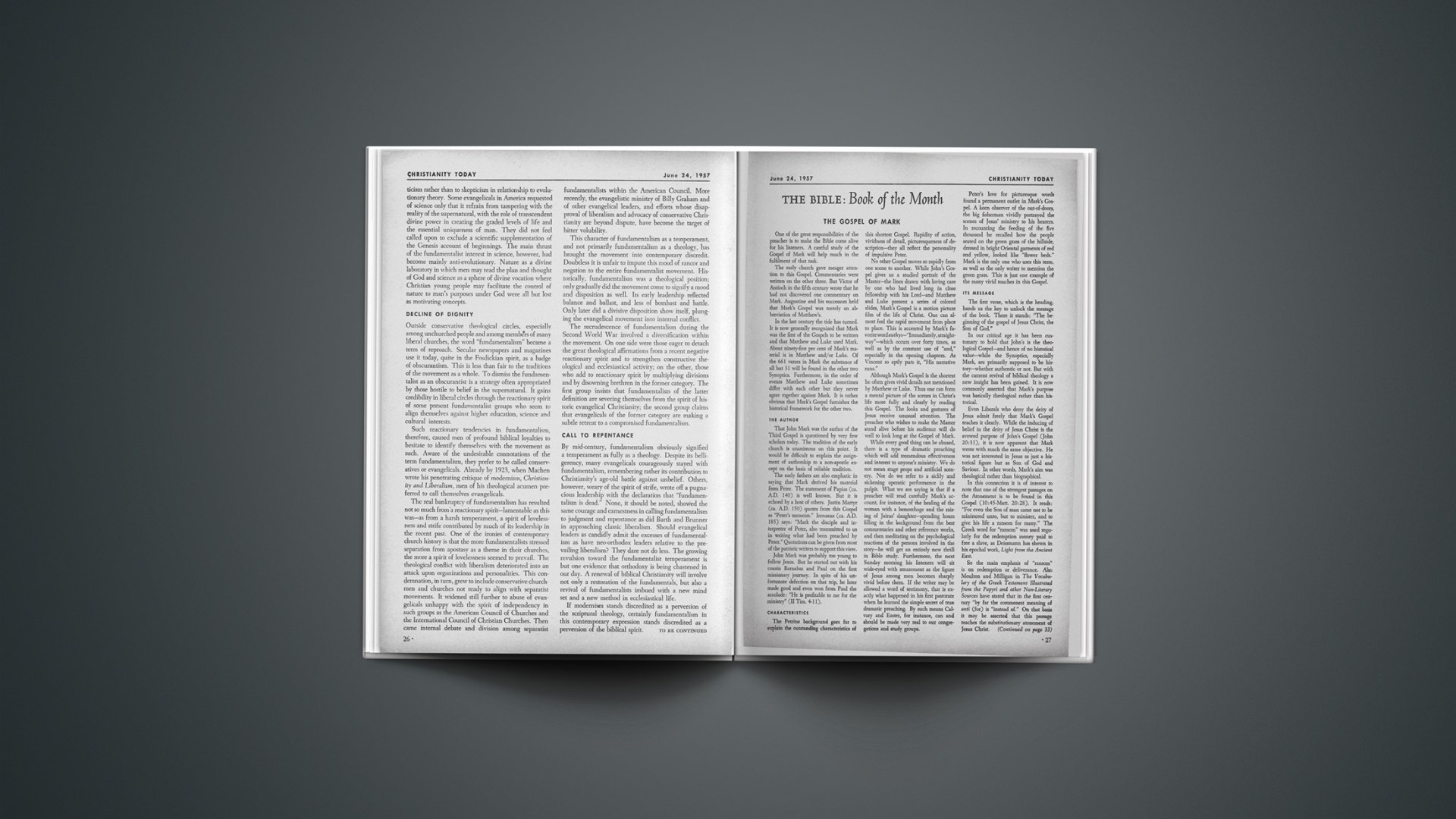One of the great responsibilities of the preacher is to make the Bible come alive for his listeners. A careful study of the Gospel of Mark will help much in the fulfilment of that task.
The early church gave meager attention to this Gospel. Commentaries were written on the other three. But Victor of Antioch in the fifth century wrote that he had not discovered one commentary on Mark. Augustine and his successors held that Mark’s Gospel was merely an abbreviation of Matthew’s.
In the last century the tide has turned. It is now generally recognized that Mark was the first of the Gospels to be written and that Matthew and Luke used Mark. About ninety-five per cent of Mark’s material is in Matthew and/or Luke. Of the 661 verses in Mark the substance of all but 31 will be found in the other two Synoptics. Furthermore, in the order of events Matthew and Luke sometimes differ with each other but they never agree together against Mark. It is rather obvious that Mark’s Gospel furnishes the historical framework for the other two.
The Author
That John Mark was the author of the Third Gospel is questioned by very few scholars today. The tradition of the early church is unanimous on this point. It would be difficult to explain the assignment of authorship to a non-apostle except on the basis of reliable tradition.
The early fathers are also emphatic in saying that Mark derived his material from Peter. The statement of Papias (ca. A.D. 140) is well known. But it is echoed by a host of others. Justin Martyr (ca. A.D. 150) quotes from this Gospel as “Peter’s memoirs.” Irenaeus (ca. A.D. 185) says: “Mark the disciple and interpreter of Peter, also transmitted to us in writing what had been preached by Peter.” Quotations can be given from most of the patristic writers to support this view.
John Mark was probably too young to follow Jesus. But he started out with his cousin Barnabas and Paul on the first missionary journey. In spite of his unfortunate defection on that trip, he later made good and even won from Paul the accolade: “He is profitable to me for the ministry” (2 Tim. 4:11).
Characteristics
The Petrine background goes far to explain the outstanding characteristics of this shortest Gospel. Rapidity of action, vividness of detail, picturesqueness of description—they all reflect the personality of impulsive Peter.
No other Gospel moves so rapidly from one scene to another. While John’s Gospel gives us a studied portrait of the Master—the lines drawn with loving care by one who had lived long in close fellowship with his Lord—and Matthew and Luke present a series of colored slides, Mark’s Gospel is a motion picture film of the life of Christ. One can almost feel the rapid movement from place to place. This is accented by Mark’s favorite word euthys—“Immediately, straightway”—which occurs over forty times, as well as by the constant use of “and,” especially in the opening chapters. As Vincent so aptly puts it, “His narrative runs.”
Although Mark’s Gospel is the shortest he often gives vivid details not mentioned by Matthew or Luke. Thus one can form a mental picture of the scenes in Christ’s life more fully and clearly by reading this Gospel. The looks and gestures of Jesus receive unusual attention. The preacher who wishes to make the Master stand alive before his audience will do well to look long at the Gospel of Mark.
While every good thing can be abused, there is a type of dramatic preaching which will add tremendous effectiveness and interest to anyone’s ministry. We do not mean stage props and artificial scenery. Nor do we refer to a sickly and sickening operatic performance in the pulpit. What we are saying is that if a preacher will read carefully Mark’s account, for instance, of the healing of the woman with a hemorrhage and the raising of Jairus’ daughter—spending hours filling in the background from the best commentaries and other reference works, and then meditating on the psychological reactions of the persons involved in the story—he will get an entirely new thrill in Bible study. Furthermore, the next Sunday morning his listeners will sit wide-eyed with amazement as the figure of Jesus among men becomes sharply vivid before them. If the writer may be allowed a word of testimony, that is exactly what happened in his first pastorate when he learned the simple secret of true dramatic preaching. By such means Calvary and Easter, for instance, can and should be made very real to our congregations and study groups.
Peter’s love for picturesque words found a permanent outlet in Mark’s Gospel. A keen observer of the out-of-doors, the big fisherman vividly portrayed the scenes of Jesus’ ministry to his hearers. In recounting the feeding of the five thousand he recalled how the people seated on the green grass of the hillside, dressed in bright Oriental garments of red and yellow, looked like “flower beds.” Mark is the only one who uses this term, as well as the only writer to mention the green grass. This is just one example of the many vivid touches in this Gospel.
Its Message
The first verse, which is the heading, hands us the key to unlock the message of the book. There it stands: “The beginning of the gospel of Jesus Christ, the Son of God.”
In our critical age it has been customary to hold that John’s is the theological Gospel—and hence of no historical value—while the Synoptics, especially Mark, are primarily supposed to be history—whether authentic or not. But with the current revival of biblical theology a new insight has been gained. It is now commonly asserted that Mark’s purpose was basically theological rather than historical.
Even Liberals who deny the deity of Jesus admit freely that Mark’s Gospel teaches it clearly. While the inducing of belief in the deity of Jesus Christ is the avowed purpose of John’s Gospel (John 20:31), it is now apparent that Mark wrote with much the same objective. He was not interested in Jesus as just a historical figure but as Son of God and Saviour. In other words, Mark’s aim was theological rather than biographical.
In this connection it is of interest to note that one of the strongest passages on the Atonement is to be found in this Gospel (Matt. 20:28–Mk. 10:45). It reads: “For even the Son of man came not to be ministered unto, but to minister, and to give his life a ransom for many.” The Greek word for “ransom” was used regularly for the redemption money paid to free a slave, as Deissmann has shown in his epochal work, Light from the Ancient East.
So the main emphasis of “ransom” is on redemption or deliverance. Also Moulton and Milligan in The Vocabulary of the Greek Testament Illustrated from the Papyri and other Non-Literary Sources have stated that in the first century “by far the commonest meaning of anti (for) is “instead of.” On that basis it may be asserted that this passage teaches the substitutionary atonement of Jesus Christ. Certainly this Gospel is more than a mere chronicle of events. It is history interpreted—theologically.
Outline
The Gospel of Mark may be divided several ways. Since Mark presents Jesus as the “Servant of the Lord” one possible outline would be as follows: I. The Filial Servant (1:1–13); II. The Conquering Servant (1:14–13:37); III. The Suffering Servant (cc. 14–16). Perhaps a better outline would be: I. The Period of Preparation (1:1–13); II. The Galilean Ministry (1:14–9:50); III. The Perean Ministry (c. 10); IV. The Judean Ministry (cc. 11–13); V. The Passion Narrative (cc. 14–16).
As is the case with the other Gospels, Mark may be considered a drama of the life, death and resurrection of Jesus Christ. The hero is presented to Roman readers as the great conqueror—over disease, death and demons. He alone could still the storm by two words uttered on the Lake of Galilee. Master of every situation he met, he fed the hungry multitude with five little barley biscuits and two small fish. He was the greatest Conqueror of all time.
Yet his friends misunderstood him and his enemies conspired against him. Finally came the climax in his crucifixion and burial. The one who offered himself as Messiah on Sunday morning was five days later condemned to death and hanged on a cross. The end had come.
But it was not the end—nor even the climax. The latter came in his resurrection, when he showed himself conqueror forever over death and hades. He stepped out of the grave into a new life—for all who would follow Him in eternal life, here and hereafter. So for the believer there is no end to “the gospel of Jesus Christ, the Son of God.” Mark, as he says (1:1), just records “the beginning of the gospel.”
Tools For Exposition
One of the best commentaries on Mark is A Practical Commentary on the Gospel According to St. Mark, by James Morison. Here one will find a thorough discussion of every passage and almost every phrase. Long out of print, it can sometimes be secured from used book stores.
As with all his works, Joseph Addison Alexander’s volume on Mark is rich in expositional and devotional material. Fortunately it has recently been reprinted. Among the better recent commentaries on the English text is Lenski’s Interpretation of St. Mark’s Gospel. In The Interpreter’s Bible the exegesis by F. C. Grant is meager and disappointing. But the exposition by Luccock is excellent. Here one finds fresh preaching material beamed to the problems and situations of our day. While the old standard commentaries are still unsurpassed for their presentation of the great principles of scriptural truth, the preacher should have a few recent commentaries to help him in making his applications pertinent. Incidentally, of course, the newer works are also needed to bring one up to date on matters of geography, chronology and archaeology, as well as on significant items of historical and textual criticism.
For a thorough study some commentaries on the Greek text are absolutely indispensable. The old standard work by Swete has been somewhat superseded by Vincent Taylor’s recent monumental volume, The Gospel According to St. Mark. It will be a long time before this is surpassed in thoroughness and scholarship.
Of more immediate value to the average preacher is Alfred Plummer’s volume in the Cambridge Greek Testament (new series). All of Plummer’s many commentaries are superior. A. B. Bruce writes on the synoptic Gospels in The Expositor’s Greek Testament. The present writer has found this set of five volumes to be the best single commentary series on the entire New Testament.
For a satisfactory study of any of the Gospels a harmony is needed. The best on the four Gospels is that by A. T. Robertson or the recent Gospel Records by A. C. Wieand. On the synoptic Gospels we recommend Gospel Parallels, published by Nelson.
RALPH EARLE










